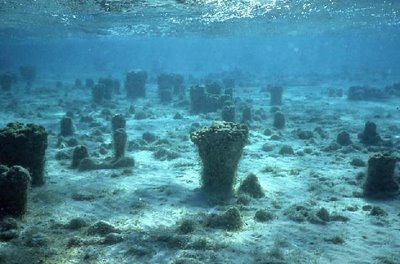
[Image: New Scientist].
"Fed by underground waters coursing through the mountains' limestone layers and caves, as well as gushing up from deep and ancient aquifers, the pools – or pozas as the locals call them – have strange chemistries. Phosphorus tends to be in short supply, whereas calcium, magnesium and sulphur are richly available... Primitive microbes flourish here."
Some of these marshes are choked with "microbial mats. Under certain conditions, some microbes, such as photosynthetic cyanobacteria, sulphur-reducing bacteria, nitrogen-fixing bacteria and other helpful waste-eaters, glue themselves together into slimy cooperatives that are often layered like a cake. The incorporation of silt and minerals creates a harder structure, a 'living rock' called a stromatolite."

[Image: An underwater field of stromatolites, from MIT's geobiology lab].
These ecosystems are so chemically abrasive and oddly unlifelike that scientists from Caltech's Virtual Planetary Laboratory hope they might even reveal what forms organisms could take on other planets.
(For a bit more on this see Lunar urbanism 3 or Super Reef; and for some very vaguely – in fact really not – related photographs, see this interview with David Maisel).
No comments:
Post a Comment